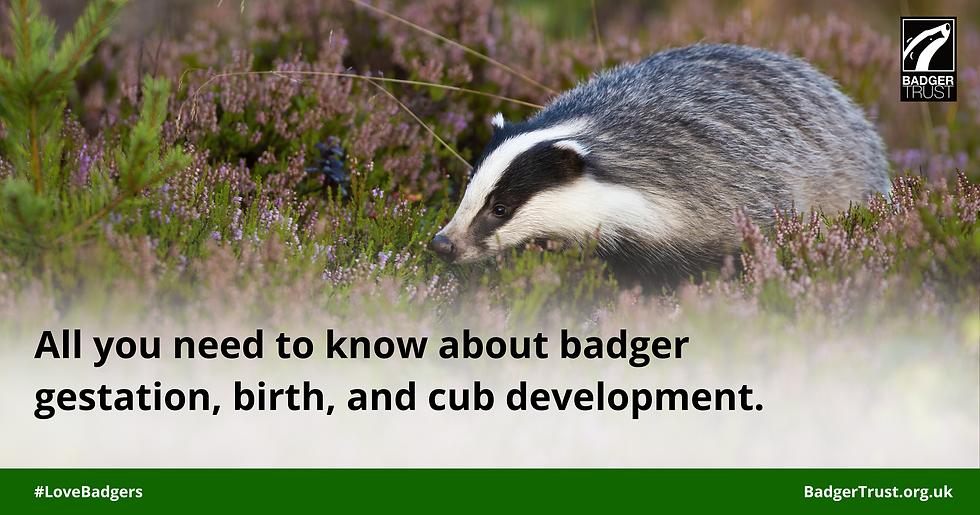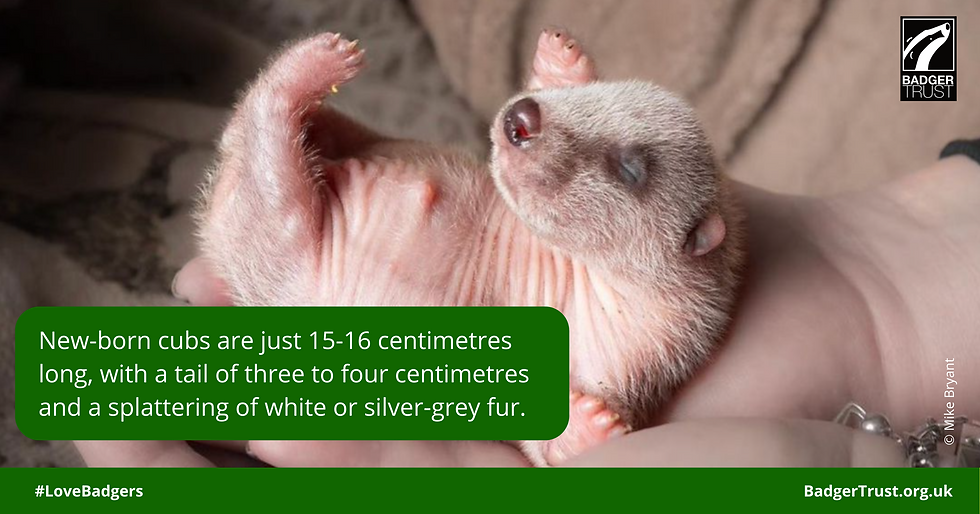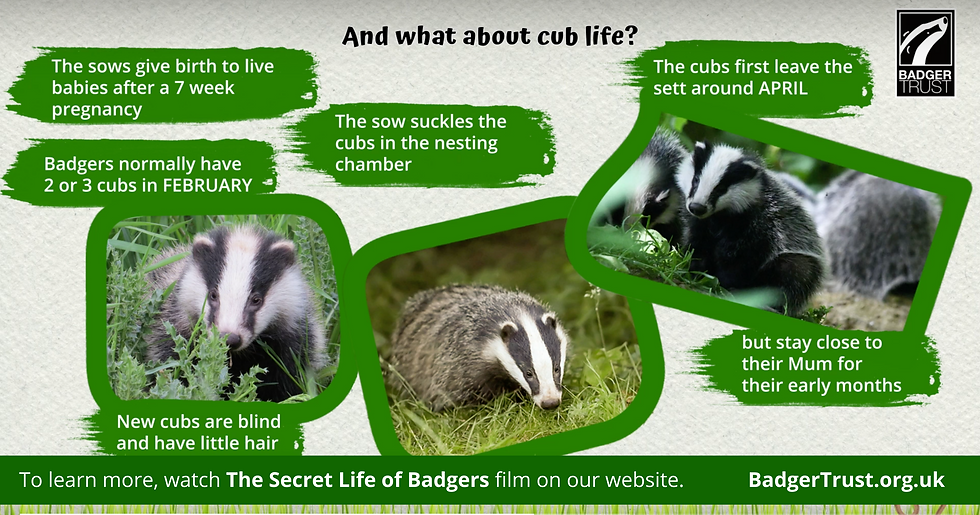February is here, and so are this year's baby badgers
- Badger Trust Staff Team

- Feb 1, 2023
- 5 min read
Updated: May 2, 2024
All you need to know about badger gestation, birth, and cub development.

Whilst we won’t see them until April or May, badger cubs are usually born in February throughout England and Wales. Births can, however, occur later or earlier depending on the local climate, resource availability, and the health of the sow.
Usually, mothers will give birth to one or two cubs at a time, though a litter can be up to five baby badgers!

New-born cubs are just 15-16 centimetres long, with a tail of three to four centimetres and a splattering of white or silver-grey fur. At birth, baby badgers can weigh as little as 75 grams or as much as 132 grams. That's the difference between a kiwi and an orange.
Badger cubs are altricial, meaning they are born under-developed and rely on parental care to survive [1]. In addition, whereas dogs open their eyes at two weeks of age, badger cubs have their eyes and ear canals firmly shut for the first five weeks of life [2]. This makes them particularly vulnerable, which is why winter is such a vital time for sows preparing for the cub's arrival.
What have badger mothers been doing over winter?
Winter is a quiet time for badgers, who will be tucked up safe and warm in the comfort of their sett chambers. All badgers, including pregnant sows, spend the winter months, when it’s coldest, in a state of torpor. Torpor is a state of lowered physiological activity, including reduced metabolism, heart rate, respiration, and body temperature [3].
Why do badgers go into torpor?
Torpor enables badgers to survive the winter without needing to feed every day. Feeding in winter takes a lot of energy, so badgers would need to eat more food at a time of year when it’s scarce. Instead, torpor enables badgers to rely on their own body fat reserves, and if they do get hungry, they can emerge for short periods, which is not the case for hibernating animals.
A mother-to-be will need to preserve as much energy as she can – not only is she pregnant throughout winter, but she’ll need all the stamina she can muster once the babies are here!
December and January are when sows are pregnant. In preparation for giving birth, sows will select a larger-than-average chamber in the sett – she’ll need room for herself and her litter when they arrive in February [4].
Her selected maternal chamber will be located near an entrance where it can be well-ventilated and more easily defended against intruders than chambers deeper within the sett [3].
How long are female badgers pregnant?
Scientists estimate badger gestation averages at 49 days, but this is still subject to research [3]. Why? Because one of the most fascinating things about badger reproduction is that badgers can delay implantation, a phenomenon known as embryonic diapause [5]. Embryonic diapause is where an egg is fertilized soon after mating, but the cub will not be born until several months later. Shortly after mating, the fertilised egg develops into a very early foetus known as a blastocyst; development then slows down almost to a standstill.
The blastocyst floats around in the female's womb until December or early January when the short day length triggers hormonal signals that cause changes in the womb and cause the blastocyst to implant in the wall lining. Once implanted, the early embryo resumes its normal development and completes its transformation into becoming a fully-formed cub.
Why do badgers wait until winter for implantation?
Badgers will delay implantation until winter to ensure that their offspring are born in February. Like humans, badger cubs are born completely dependent upon parental care for survival and so will stay in the sett feeding on milk for the first three months of their life. By the time the cubs are independent enough to explore outside the sett, the climate has warmed up and the cubs are able to survive above ground.
So what’s next for badger cubs in February?
For the first ten days of life, badger cubs will spend their time tucked up in the safety of the maternal chamber, where they will sleep, feed, and sleep some more!

At ten days of age, despite still mainly being immobile, the mother will begin to sporadically pick up each cub and carry them into different chambers within the sett [4]. By moving the cubs, the mother keeps them and their maternal chamber free of parasites.
Unfortunately, despite its many advantages, one of the tradeoffs of communal living is sharing parasites. Fleas can jump 10cm, so moving cubs between different chambers (alongside allogrooming) keeps the main breeding chamber free from an overburden of fleas [6]. No one likes to be itchy!
However, some of the benefits of communal living are allogrooming and alloparenting. Whilst sows predominantly attend to the care of their own young alone, other badgers in the clan will enter the breeding chamber to groom the cubs to help keep the parasitic load at low levels [4, 6].
What’s next for sows?
February is a very busy month for badger mothers. Once she has given birth, a sow will come back into oestrus straight away [2]. This change in physiological status attracts the attention of males who will attempt to mate with her.
When is badger mating season?
Badgers can breed throughout the year, though the mating season is loosely defined as between February and March, as this is when most mating occurs. If you listen carefully at this time of year, you’ll likely hear the noisy affair of badger mating season. Male badgers will use a special vocalisation called a “churr” to indicate their arousal and non-aggressive intent [3, 4].
What does a badger “churr” sound like?
Churrs have a distinct “oily” and “bubbly” sound to them [5, 6]. Each male badger has a distinct churr, unique to them, which helps males and females to distinguish between individuals [3]. If you’re an avid badger watcher, can you tell the difference between clan members?
What’s next for badger champions?
How you can learn more about badgers and how you can support them.
Badgers are a fascinating species that brings joy to millions of nature enthusiasts across England and Wales. And whilst we eagerly await the spring months when we can get our first glimpse of this year’s inquisitive cubs, we can wait out February in the comfort of knowing exactly what our newest generation of clan members are up to below ground.
How can you learn more about badgers?
You can learn even more about badgers through Badger Trust’s badger education hub, where you’ll find lots of FREE resources to help with learning at home and school.

Our learning resources are designed to support educators and learners to explore everything about badgers, their habitats and the issues they face.
How can you support badgers?
There are many ways you can help us support badgers. You can actively support Badger Trust campaigns by donating, joining our badger clan by becoming a Supporter, and you can purchase products that make a difference through the Brock Shop.
Want to get even more hands-on? Get involved and volunteer with your local Badger Group to be on the front-line of the badger protection action.
References and further information:
[1]. Sugianto, N.A., Newman, C., Macdonald, D.W. and Buesching, C.D., 2019. Extrinsic factors affecting cub development contribute to sexual size dimorphism in the European badger (Meles meles). Zoology, 135, p.125688.
[2]. Roper, T. J. 2010. Badger. Volume 114. London: Harper Collins.
[3]. Clark, M., 2010. Badgers. Essex: Whittet Books.
[4]. Macdonald, D. W., and Newman, C. 2022. The badgers of Whytham Woods: A model for behaviour, ecology and evolution. Oxford: Oxford Press.
[5]. Yamaguchi, N., Dugdale, H.L. and Macdonald, D.W., 2006. Female receptiveity, embryonic diapause, and superfetation in the European Badger (Meles Meles: implications for the reproductive tactics of males and females. The Quarterly Review of Biology, 81(1), pp.33-48.
[6]. Stewart, P.D. and Macdonald, D.W., 2003. Badgers and badger fleas: strategies and counter-strategies. Ethology, 109(9), pp.751-764.



